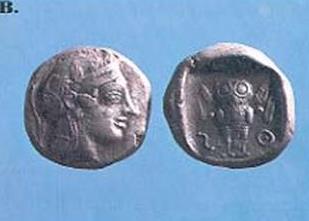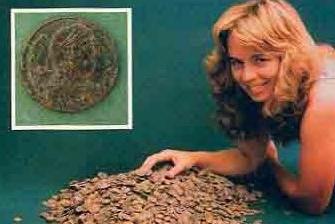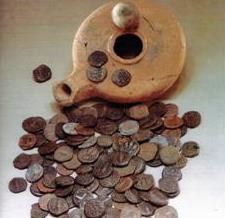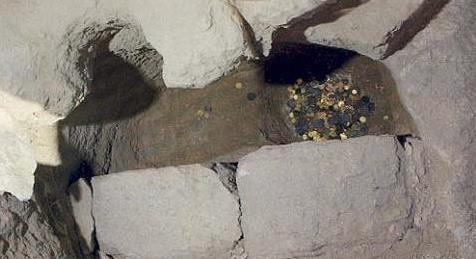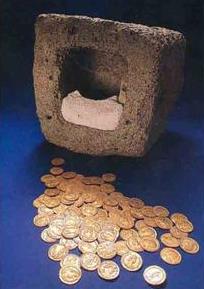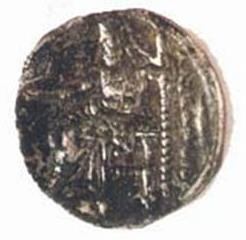Home » Archives for May 2008
Archive for May, 2008
400 Gold Coins from 6th and 7th centuries CE at Beth Shean, discovered in 1997. The Israel Antiquities Authority was performing a rescue excavation at a site where a youth hostel will be constructed when archaeologists unearthed a large ceramic jug holding two to four hundred gold coins from the sixth or seventh century A.D. […]
Athenian Coin This coin was a local imitation of an Athenian coin. It is a silver tetradrachma minted in Gaza in the 5th century B.C. The profile head is the goddess, Pallas Athena, and on the opposite side is the owl, her holy bird. The Holy Land in Coins, Yaakov Meshorer, BAR Mar 1978.
Qazrin Coin Hoard The final hour of the final day of the Qatzrin dig brought to light a hoard of 9,000 bronze coins, seen here with archaeologist Ann Killebrew. Some of the coins (example inset) were minted by Julian the Apostate and bear his image. “Coin Hoard Found at Qatzrin on Last Day of Dig,” […]
Ein Gedi Synagogue The floor of the western aisle, through which one entered the prayer hall, included five inscriptions. These include an Aramaic inscription mentioning the local community as well as private donors who contributed toward the construction and maintenance of the synagogue. One inscription also includes a warning and a curse- Warnings to […]
Glass and gold beads, a stick used for applying makeup, an alabaster bowl, a pendant, bronze mirrors, a necklace, an oil lamp, and a Babylonian stamp bearing the figure of a priest worshiping the moon god found in a cave near Ein Gedi. The artifacts date to the Shivat Zion (“Return of Zion”) era, after […]
The fifth-to seventh-century C.E. inscription preserved in the mosaic floor of the narthex to the west of the Ein Gedi synagogue sanctuary contains 18 lines and 118 words. Until the discovery of the Rehov inscription (text 12.2.1), this was the longest synagogue inscription known from Roman Palestine. 1. Adam, 76 Seth, Enosh, Kenan, Mahalalel, Jared, […]
Coin Hoard from Ein Gedi The excavations of En-Gedi yielded 1,247 coins, most of them (about 80%) from the area of the village. Such a large number of coins is indicative of intensive economic activity. Two hoards of gold coins, one consisting of 15 coins of Justinian (527-565) and the other comprising five coins of […]
Coin Hoard from Meroth The richest treasury of coins ever found in an ancient synagogue, this hewn pit beneath a storeroom floor in the Meroth synagogue held 485 coins, 245 of them gold and 240 bronze. Excavators even found a bronze scale in the treasury (see photograph). Most of the coins are Byzantine. The gold […]
Gold Hoard from Caesarea One of Israel’s richest archaeological sites—abounding with sculpture, mosaics, pottery, glassware, coins and more—Caesarea Maritima still holds surprises after 21 years of excavation, as two discoveries last season show. In a curious reprise of the recent silver-cache finds at Tel Miqne-Ekron,a volunteers from Concordia College (Moorhead, Minnesota), working at Caesarea under […]
This silver drachma coin struck in 323 B.C.E. is among the artifacts that provided evidence for the dating of the “cigarette” scroll. The “cigarette” scroll, found in a cave at Ketef Jericho rolled up into a cigarette-like tube, has helped to substantiate the science of paleography. This Aramaic document is a ledger, listing on one […]


